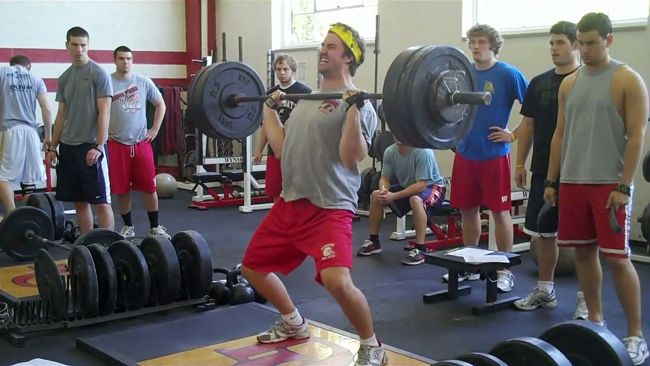
It’s extremely important that athletes perform Olympic lifts correctly. This means teaching lifts through a progression designed to implement proper form. Doing the lifts incorrectly, which is the case with the vast majority of young athletes, reduces the effect of the lift and creates a much higher likelihood of injury.
This article will discuss how to perform progressions of one of the absolute, most effective lifts that every high level athlete regularly uses in his or her training program—the power clean. This exercise is fundamental for creating explosive power. It’s also an exercise that many athletes do incorrectly. When performing or teaching this exercise, if the athletes aren’t performing all of the actions as they’re described, back off of the weight and continue to follow the progressions. Here are some great progressions to start with before you introduce the entire clean.
Clean Romanian deadlift
Stand with the barbell in your hands, the feet at hip width, shoulders back, and chest up. Keeping the arms straight and your eyes fixed straight ahead, lower the bar by moving the hips backward while maintaining a slight but fixed bend in the knees. Stop once the bar reaches the top of the knees or when the flexibility in the hamstrings runs out. Quickly return to the starting position by moving the hips forward and standing up straight.
Clean Romanian deadlift to power shrug
Stand with the barbell in your hands, the feet at hip width, shoulders back, and chest up. Keeping the arms straight and your eyes fixed straight ahead, lower the bar by moving the hips backward while maintaining a slight but fixed bend in the knees. Stop once the bar reaches the top of the knees or when the flexibility in the hamstrings runs out. Quickly move the hips forward. As the hips extend explosively, shrug the shoulders and rise up on the toes.
Clean Romanian deadlift to high pull
Stand with the barbell in your hands, your feet at hip width, your shoulders back, and your chest up. Keeping the arms straight and your eyes fixed straight ahead, lower the bar by moving the hips backward while maintaining a slight but fixed bend in the knees. Stop once the bar reaches the top of the knees or when the flexibility in the hamstrings runs out. Quickly move the hips forward. As the hips extend explosively, shrug the shoulders and rise up on the toes. Continue to elevate the bar to mid-chest height by bending the elbows and continuing the upward movement of the bar. Be sure to lift your elbows up and keep the bar close to the body.
Muscle clean
Standing erect with the barbell in your hands with a clean grip and feet at hip width, slide the bar upward almost along the body to near shoulder height. Once at shoulder height, rotate the elbows underneath the bar, release the hook grip, and let the bar fall onto the shelf created by the shoulders. Return the bar to the starting position in the same way that it got there.
Power clean
Stand with the barbell in your hands, feet at hip width, shoulders back, and chest up. Keeping your arms straight and your eyes fixed straight ahead, lower the bar by moving the hips backward while maintaining a slight but fixed bend in the knees. Stop once the bar reaches the top of the knees or when the flexibility in the hamstrings runs out.
Quickly move the hips forward. As the hips extend explosively, shrug the shoulders and rise up on the toes. Continue to elevate the bar to mid-chest height by bending the elbows and continuing the upward movement of the bar. Be sure to lift your elbows up and keep the bar close to your body. Once at shoulder height, simultaneously rotate the elbows underneath the bar, release the hook grip, let the bar fall onto the shelf created by the shoulders, and fall into a quarter squat. The quarter squat should be reached at the same time that the barbell is received on the shoulders.
Teaching Olympic lifting is much easier if you first break down each of the movements. Once your athlete has perfected each individual movement, they’ll find that performing the whole clean is a much simpler task. Also, if you have an athlete struggling with a particular stage of the lift, you can use these exercises to “clean up” their form.
Elite Fitness Systems strives to be a recognized leader in the strength training industry by providing the highest quality strength training products and services while providing the highest level of customer service in the industry. For the best training equipment, information, and accessories, visit us at www.EliteFTS.com.








